
 |
|
Star Wars: Episode III Cast: Ewan McGregor, Hayden Christensen, Natalie Portman, Ian McDiarmid, Samuel L. Jackson, Jimmy Smits, Christopher Lee, Kenny Baker, Keisha Castle-Hughes, Peter Mayhew. Voices: Frank Oz, Anthony Daniels, Matthew Wood, James Earl Jones. 2005 – 140 minutes Rated: Reviewed by Dustin Putman, May 19, 2005. 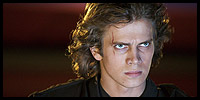 After twenty-eight years and six films, the epic, much-loved "Star Wars" series has finally come full circle with "Star Wars: Episode III - Revenge of the Sith." From a visual standpoint, what can be said that hasn't been said before? Writer-director George Lucas has created another technological feast for the eyes—grand, majestic, and continuously awe-inspiring—and what he seriously lacks as a writer of dialogue he more than makes up for in eye-opening creativity and top-of-the-line visionary artistry. He elaborates on bold, fantastical worlds that exist solely from his own imagination, bringing them to life with the best of the best in visual effects, all the while coming up with fresh, new action set-pieces unlike anything seen in the previous installments.
After twenty-eight years and six films, the epic, much-loved "Star Wars" series has finally come full circle with "Star Wars: Episode III - Revenge of the Sith." From a visual standpoint, what can be said that hasn't been said before? Writer-director George Lucas has created another technological feast for the eyes—grand, majestic, and continuously awe-inspiring—and what he seriously lacks as a writer of dialogue he more than makes up for in eye-opening creativity and top-of-the-line visionary artistry. He elaborates on bold, fantastical worlds that exist solely from his own imagination, bringing them to life with the best of the best in visual effects, all the while coming up with fresh, new action set-pieces unlike anything seen in the previous installments.
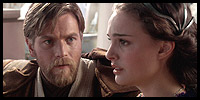 1999's "Star Wars: Episode I - The Phantom Menace" and 2002's "Star Wars: Episode II - Attack of the Clones" have been rightfully criticized for the clunky, stilted dialogue Lucas writes, shamelessly embracing the most decrepit and cheesy of cliches. Someone like Peter Jackson, for instance, avoided this pitfall; his "Lord of the Rings" trilogy featured serious characterizations and plot depth to go along with his stunning visual components. Whereas "Star Wars" has received more than its share of bad laughs in the past—the romance in the otherwise solid "Episode II" reached a new level of cornball—skeptics will be pleased to find that, this time, Lucas has corrected many of his wrongs. He still has a tendency to spell things out for viewers rather than show them—characters tend to announce how they feel even as they struggle to emote the said feeling—but there are far less glaring spoken embarrassments than his past two films. Mostly, Lucas cuts to the chase, injecting his finale (or, at least, the finale of the first three-parter) with the no-nonsense seriousness it deserves.
1999's "Star Wars: Episode I - The Phantom Menace" and 2002's "Star Wars: Episode II - Attack of the Clones" have been rightfully criticized for the clunky, stilted dialogue Lucas writes, shamelessly embracing the most decrepit and cheesy of cliches. Someone like Peter Jackson, for instance, avoided this pitfall; his "Lord of the Rings" trilogy featured serious characterizations and plot depth to go along with his stunning visual components. Whereas "Star Wars" has received more than its share of bad laughs in the past—the romance in the otherwise solid "Episode II" reached a new level of cornball—skeptics will be pleased to find that, this time, Lucas has corrected many of his wrongs. He still has a tendency to spell things out for viewers rather than show them—characters tend to announce how they feel even as they struggle to emote the said feeling—but there are far less glaring spoken embarrassments than his past two films. Mostly, Lucas cuts to the chase, injecting his finale (or, at least, the finale of the first three-parter) with the no-nonsense seriousness it deserves.
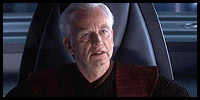 Anyone with even a passing knowledge of the "Star Wars" lore will know what to expect in "Star Wars: Episode III - Revenge of the Sith," which acts as a bridge connecting the two trilogies. Where this one ends, 1977's "Star Wars: Episode IV - A New Hope" begins, and the transition is amazingly close to seamless. In that respect, there are few surprises in the narrative this time around. We know, for example, that Jedi Knight Anakin Skywalker (Hayden Christensen) must be seduced to the Dark Side and brainwashed into thinking the Jedi Council is the enemy, ultimately becoming Darth Vader. Because of this, we know that he will have a falling-out with Jedi Master and mentor Obi-Wan Kenobi (Ewan McGregor) that will lead to a bond forever destroyed. We know that Chancellor Palpatine (Ian McDiarmid) will be revealed as the evil Darth Sidius, who puppets Anakin's transformation. We know, also, that his secret wife, former Queen of Naboo Padme Amidala (Natalie Portman), will become pregnant and die during childbirth, leading to the separation of newborn twins Luke and Leia. And we know that, by the time all is said and done, the once peaceful Republic—and planet Coruscant—will be in total ruin, transformed into the First Galactic Empire with little seeming hope of being mended.
Anyone with even a passing knowledge of the "Star Wars" lore will know what to expect in "Star Wars: Episode III - Revenge of the Sith," which acts as a bridge connecting the two trilogies. Where this one ends, 1977's "Star Wars: Episode IV - A New Hope" begins, and the transition is amazingly close to seamless. In that respect, there are few surprises in the narrative this time around. We know, for example, that Jedi Knight Anakin Skywalker (Hayden Christensen) must be seduced to the Dark Side and brainwashed into thinking the Jedi Council is the enemy, ultimately becoming Darth Vader. Because of this, we know that he will have a falling-out with Jedi Master and mentor Obi-Wan Kenobi (Ewan McGregor) that will lead to a bond forever destroyed. We know that Chancellor Palpatine (Ian McDiarmid) will be revealed as the evil Darth Sidius, who puppets Anakin's transformation. We know, also, that his secret wife, former Queen of Naboo Padme Amidala (Natalie Portman), will become pregnant and die during childbirth, leading to the separation of newborn twins Luke and Leia. And we know that, by the time all is said and done, the once peaceful Republic—and planet Coruscant—will be in total ruin, transformed into the First Galactic Empire with little seeming hope of being mended.
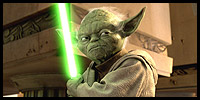 The first in the series to be rated PG-13 and the darkest by a mile, "Star Wars: Episode III - Revenge of the Sith" transcends the comparable frothy fun and games of the last two films into a Greek tragedy of surprisingly potent emotions and intensity. With almost nothing in the way of comic relief—the overhated Jar-Jar Binks has a wordless cameo in a few scenes, and even wisecracking androids R2-D2 and C-3PO play things understatedly—George Lucas relishes getting down and dirty, offering no relief and no respite to the calamitous turn of events his characters face. In zeroing in on the inherently good, heroic Anakin's plight and plausibly depicting the defeat over his own humanity, Lucas has successfully found the humanity within this mournful character's arc. Darth Vader may be one of the most famed villains in movie history, but now audiences actually get to see and understand how he became who he is, and how he lost who he was.
The first in the series to be rated PG-13 and the darkest by a mile, "Star Wars: Episode III - Revenge of the Sith" transcends the comparable frothy fun and games of the last two films into a Greek tragedy of surprisingly potent emotions and intensity. With almost nothing in the way of comic relief—the overhated Jar-Jar Binks has a wordless cameo in a few scenes, and even wisecracking androids R2-D2 and C-3PO play things understatedly—George Lucas relishes getting down and dirty, offering no relief and no respite to the calamitous turn of events his characters face. In zeroing in on the inherently good, heroic Anakin's plight and plausibly depicting the defeat over his own humanity, Lucas has successfully found the humanity within this mournful character's arc. Darth Vader may be one of the most famed villains in movie history, but now audiences actually get to see and understand how he became who he is, and how he lost who he was.
 If the previous two entries had a fair amount of downtime as it worked to set up all of the elements leading to the conclusion, then "Star Wars: Episode III - Revenge of the Sith" is the highly charged culmination of said buildup. The action barely flags, opening with the war on the Republic already underway, masterminded by Count Dooku (Christopher Lee) and leader of the droid armies, General Grievous (voiced by Matthew Wood). This large-scale space battle, something that was missing from "Episode II," exhilaratingly feels like being on a roller coaster and is just the shot of adrenaline needed to start things off with a bang. Other standout sequences include the outcome of Jedi Mace Windu (Samuel L. Jackson), which is a major turning point in Anakin's transformation to the Dark Side; the final, heartbreaking confrontation between doomed lovers Anakin and Padme, which holds a sense of connection and more genuine emotion than any other within these two's otherwise combustibly developed romance; and the significant lightsaber battle between Anakin and Obi-Wan amidst a sea of exploding lava.
If the previous two entries had a fair amount of downtime as it worked to set up all of the elements leading to the conclusion, then "Star Wars: Episode III - Revenge of the Sith" is the highly charged culmination of said buildup. The action barely flags, opening with the war on the Republic already underway, masterminded by Count Dooku (Christopher Lee) and leader of the droid armies, General Grievous (voiced by Matthew Wood). This large-scale space battle, something that was missing from "Episode II," exhilaratingly feels like being on a roller coaster and is just the shot of adrenaline needed to start things off with a bang. Other standout sequences include the outcome of Jedi Mace Windu (Samuel L. Jackson), which is a major turning point in Anakin's transformation to the Dark Side; the final, heartbreaking confrontation between doomed lovers Anakin and Padme, which holds a sense of connection and more genuine emotion than any other within these two's otherwise combustibly developed romance; and the significant lightsaber battle between Anakin and Obi-Wan amidst a sea of exploding lava.
 The performances, less than naturalistic in the past, are also a noted improvement, particularly from Hayden Christensen (2003's "Shattered Glass"), whose Anakin isn't as annoying and whiny this time around, even if he does look remarkably similar to a heroin junkie, and Natalie Portman (2004's "Garden State"), who is so very powerful even with reduced screen time that she is acting on a whole different level than everyone else around her. Portman, a class-act thespian, may never have been suited for a special effects-laden fantasy to begin with, but she plays things with the sort of conviction she might in an Oscar-bound drama. As the malicious, backstabbing Chancellor Palpatine, Ian McDiarmid (1999's "Sleepy Hollow") is so good at being and looking bad that he elicits actual shivers. As for the otherworldly characters, wise, old Yoda (voiced by Frank Oz) is as crowd-pleasing as ever in a major role, droid villain General Grievous is creepy and effective, looking eerily similar the creature from 2004's "The Village," and wookie Chewbacca is introduced for the chronological first time.
The performances, less than naturalistic in the past, are also a noted improvement, particularly from Hayden Christensen (2003's "Shattered Glass"), whose Anakin isn't as annoying and whiny this time around, even if he does look remarkably similar to a heroin junkie, and Natalie Portman (2004's "Garden State"), who is so very powerful even with reduced screen time that she is acting on a whole different level than everyone else around her. Portman, a class-act thespian, may never have been suited for a special effects-laden fantasy to begin with, but she plays things with the sort of conviction she might in an Oscar-bound drama. As the malicious, backstabbing Chancellor Palpatine, Ian McDiarmid (1999's "Sleepy Hollow") is so good at being and looking bad that he elicits actual shivers. As for the otherworldly characters, wise, old Yoda (voiced by Frank Oz) is as crowd-pleasing as ever in a major role, droid villain General Grievous is creepy and effective, looking eerily similar the creature from 2004's "The Village," and wookie Chewbacca is introduced for the chronological first time.
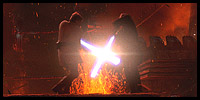 In the annals of the "Star Wars" films, "Star Wars: Episode III - Revenge of the Sith" comfortably exceeds "Episode I" and "Episode II," and is the second-best behind the reigning champion, 1980's marvelous "Episode V: The Empire Strikes Back." Destined to delight diehard fans and humble the naysayers who claimed George Lucas had lost the magic of his former trilogy, "Star Wars: Episode III - Revenge of the Sith" completes, deepens, and enriches the series beyond the pop-cultural phenomenon it has long-since made for itself. There is no happy ending to be found, and that is how it should be in order for it to smoothly transition into "A New Hope." A slam-bang summer blockbuster, the first good one of the year, the foregone conclusion that is the story "Revenge of the Sith" tells has been heightened with an unexpected haunting beauty that digs itself under the viewer's skin and stays there even after the credits have rolled and the lights have come up. For George Lucas, this is a masterful achievement that no amount of misguided screenwriting can shatter.
In the annals of the "Star Wars" films, "Star Wars: Episode III - Revenge of the Sith" comfortably exceeds "Episode I" and "Episode II," and is the second-best behind the reigning champion, 1980's marvelous "Episode V: The Empire Strikes Back." Destined to delight diehard fans and humble the naysayers who claimed George Lucas had lost the magic of his former trilogy, "Star Wars: Episode III - Revenge of the Sith" completes, deepens, and enriches the series beyond the pop-cultural phenomenon it has long-since made for itself. There is no happy ending to be found, and that is how it should be in order for it to smoothly transition into "A New Hope." A slam-bang summer blockbuster, the first good one of the year, the foregone conclusion that is the story "Revenge of the Sith" tells has been heightened with an unexpected haunting beauty that digs itself under the viewer's skin and stays there even after the credits have rolled and the lights have come up. For George Lucas, this is a masterful achievement that no amount of misguided screenwriting can shatter.
|
© 2008 by Dustin Putman |














